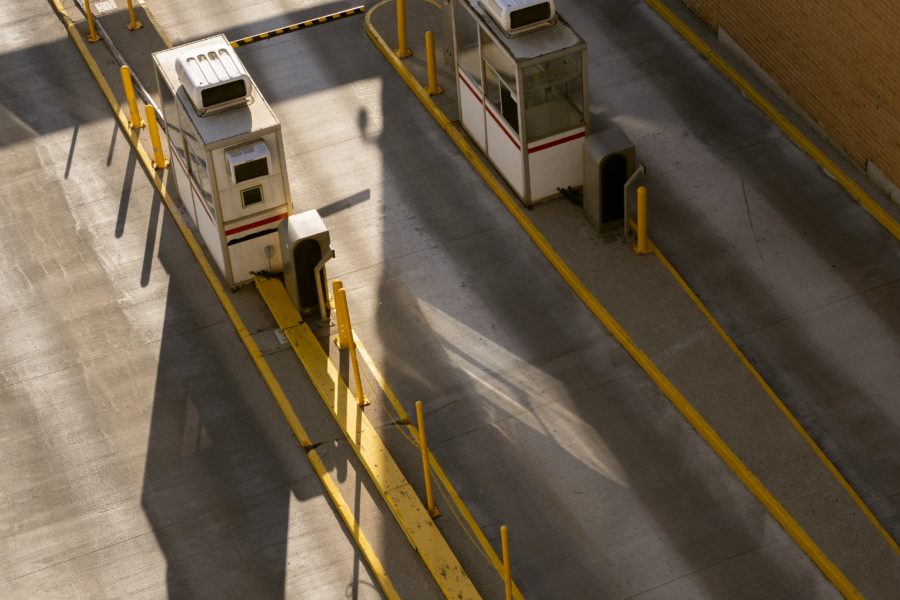
When this writer’s young son first hears the “you kids don’t know how good you have it” speech from Dad, you can bet E-ZPass will be part of the conversation.
“Transponder? Heck, we didn’t even know what a ‘trans-pond-er’ was! Back in those days you dug into your pockets for that extra quarter ’cause the rates went up all the time, and you had to sit there waiting at the booth for hours, and then you had to hand your cash over to that guy who always dropped your change on the ground! Plus you had all those people asking directions while you’re waiting, like them toll takers are AAA or somethin’! You kids today ain’t got no idea what it’s like to be searching for a dime on the floor while you’re…look at me when I’m talking to you, son.”
Yes sir, those were the good old days.
Making the switch from stopping at booths and dropping exact change in baskets to using E-ZPass to fly through a toll plaza is one of those “why did I put up with that for so long” moments in life. That little white tablet stuck to your windshield opens up a whole new world.
Suddenly getting off of the Pennsylvania Turnpike temporarily for a break or a bite to eat is a more viable option, since you no longer have to dig out a few bucks and sit at a toll booth yet one more time. An empty pocket no longer stops you from using a toll road as an alternative to a jammed freeway. Tolls for E-ZPass users are less expensive in peak times, and now using the pay as you go road for the length of a long trip isn’t such an expensive idea.
Not to mention that little bit about how WE DON’T HAVE TO SIT AND WAIT AT TOLLBOOTHS ANYMORE.
Tae Seangpeoam, (pictured) founder of Neztec Solutions, is one of the people we can thank for the considerable road stress reduction from that little invention. Seangpeoam was a senior network engineer for MFS Technologies (bought out by MCI WorldCom that year) when the company was called on to improve a promising, but fledgling, electronic toll system.
As he sat on a sofa at the Philadelphia Union League where we conducted the interview, Tae clearly enjoyed the trip down a toll-free memory lane.
“I had just come out from college,” Seangpeoam remembers. “I was almost the youngest one on the team. I was so excited; they were saying it was going to be the project of a lifetime. When you’re young, to prove yourself, you do it. I was lucky.
“E-ZPass started in 1980, the idea. But it was never successful anywhere. There were many failures due to design, engineering, and government agencies. The project would never go anywhere because it kept collapsing between authorities. My responsibility, as a senior network engineer, was to design the architecture for the telecommunication: the communication between all of the toll booths going back to New York, to the violation process center, and to the customer service center.
“During that time the main problem was billing. Sometimes it would detect an axle, sometimes not, sometimes it wouldn’t detect your license plate. The camera was not clear, it couldn’t read clearly. The system didn’t know how to match that, and it would send a wrong bill or something. Back in those days, each toll booth didn’t have anything at all. It was just bare bones toll booths. Atlantic City Expressway, Garden State Parkway, they just had manual booths.
“We went in, took a look and surveyed everything, can we feed a fiber optic line through that, or are we gonna do something else? We put satellites in several locations around Atlantic City. We did all that to link the communications back. All the transactions from the toll booth link back to the center to process, every transaction at the toll booth links back to the main frame. Also the security aspect…we had to make sure that the firewall and every single thing under the sensor is protected.
“When we launched in Delaware, it was a tremendous success. All the toll booths were connecting to each other throughout New Jersey and Delaware, all the transactions were processed at the Violation Process Center and Customer Service Center, all the tags and transponders were communicating to the system, sensor and lighting, backup video record, etc.
“The whole project was about three years; then I left the company and went to work for Verizon. I have a passion about communication; every single thing about it.”
So when you sail through the E-ZPass express lane, is there a camera taking a picture of your car and sending it to E-ZPass Mission Control to fire off the bill in the mail? Well, yes, that’s sort of what happens. But there is, of course, more to it than that.
As Seangpeoam explains, the transponder on your car connects with a sensor at the toll booth, and it sends a signal that the car with your ID is approaching. As your car is passing through, E-ZPass completes an entire profile on it…the type of car, how many axles, who owns the transponder, etc. Seangpeoam says it all has to jibe, especially the number of axles.
“If you look down the road at the toll booth, you’ll see the sensor of the treadle, to tell if your vehicle is a two-wheel, four-wheel, sixteen-wheel and so on. Those need to match to whatever the camera sees. The tag sends the signal that the car is coming, that’s what goes through the transponder. But it also sends a signal to another interface behind the scenes, to make sure that matches your transaction, because otherwise it could be a motorcycle or whatever.
Does that mean you really shouldn’t be using your transponder in your wife’s car? “You can use it in your wife’s car, but legally that’s a violation.”
This writer hasn’t yet tried that with his own tag, but Seangpeoam assures me that this contingency had been considered by the network people. “You’ll get the bill,” he says.
Today Seangpeoam runs the show at Neztec. His services, according to his business card, include real-time messaging, visual communications, and safety/compliance.

Tae Seangpeoam
“In the past 10-15 years, you’ve started to see the global economy growing,” he explains, “And every single business has to deal with rules and regulations and compliance. That becomes really complex, and it is getting more and more complex. Even the small business has to deal with certain types of compliance and regulation.
“No matter what you do, no matter how good the things you come up with, communication is always the bottom line of the process. You’ve got A, you’ve got B, how are they going to communicate?”
Has the E-ZPass experience, especially persuading state governments to cooperate with each other, given him street smarts? “Absolutely. I wouldn’t be where I am now without that knowledge.”
Today, he’s still pleased with the results of the system he helped design. As he should be. Imagine I-295 today on Thanksgiving weekend, he says, how backed up the toll booths would be, say, at the Delaware Memorial Bridge. No thanks.
“I am really proud in what I have contributed to my adopted country. I was lucky enough to be part of wonderful projects; it gave me foresight to build a career around my life, and see the future of transportation, roadways, bridges and tunnels, and infrastructure communications.”
“Less time, less energy, less frustration, people are happier, more productivity for sure. You get to your destination faster, and with less stress.
I’m proud of that because again, the purpose of communications is to take society to the next level. If you want to make a phone call right now, you push the number and it’s gonna ring on the other side. The devil is in the details no one sees, everything on the surface is very simple, very easy, but that’s why an engineer like me loves it. I love to go behind the scenes and see what makes things happen without people knowing it.
“I’m a technology guy. I love technology. However, I don’t believe in technology that comes out and makes people learn how to use it.… Do you need to learn how to use [E-ZPass]? No. You just slap it on the windshield and go. Even kids know how to use it, because it doesn’t require you to learn anything.

